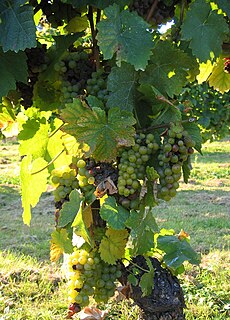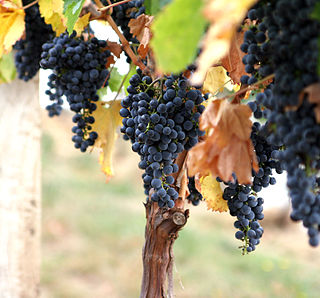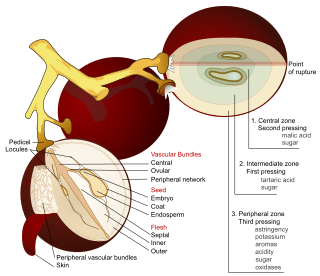
Viticulture or winegrowing is the cultivation and harvesting of grapes. It is a branch of the science of horticulture. While the native territory of Vitis vinifera, the common grape vine, ranges from Western Europe to the Persian shores of the Caspian Sea, the vine has demonstrated high levels of adaptability to new environments, hence viticulture can be found on every continent except Antarctica.

In botany, chlorosis is a condition in which leaves produce insufficient chlorophyll. As chlorophyll is responsible for the green color of leaves, chlorotic leaves are pale, yellow, or yellow-white. The affected plant has little or no ability to manufacture carbohydrates through photosynthesis and may die unless the cause of its chlorophyll insufficiency is treated and this may lead to a plant diseases called rusts, although some chlorotic plants, such as the albino Arabidopsis thaliana mutant ppi2, are viable if supplied with exogenous sucrose.

Catawba is a red American grape variety used for wine as well as juice, jams and jellies. The grape can have a pronounced musky or "foxy" flavor. Grown predominantly on the East Coast of the United States, this purplish-red grape is a likely cross of the native American Vitis labrusca and the Vitis vinifera cultivar Semillon. Its exact origins are unclear but it seems to have originated somewhere on the East coast from the Carolinas to Maryland.

Millerandage is a potential viticultural hazard problem in which grape bunches contain berries that differ greatly in size and, most importantly, maturity. Its most common cause is cold, rainy or otherwise bad weather during the flowering stage of the vines though other factors, such as boron deficiency or fanleaf degeneration, may also play a role.

Aramon or Aramon noir is a variety of red wine grape grown primarily in Languedoc-Roussillon in southern France. Between the late 19th century and the 1960s, it was France's most grown grape variety, but plantings of Aramon have been in continuous decline since the mid-20th century. Aramon has also been grown in Algeria, Argentina and Chile but nowhere else did it ever reach the popularity it used to have in the south of France.

Morio Muscat is a white wine grape that was created by viticulturalist Peter Morio at the Geilweilerhof Institute for Grape Breeding in the Palatinate in 1928. He claimed to have crossed the varieties Silvaner and Pinot blanc, but based on the variety's properties it has been speculated that he actually crossed Silvaner and Muscat Blanc à Petits Grains. But so far this speculation has yet to be conclusively proven. The grape is highly aromatic with a "grapey" characteristic reminiscent of Muscat grape varieties. The grape is rarely used for varietal wines because it requires a high level of ripeness to avoid producing wine with a "mousey" flavor, a coarse texture and overabundance of acidity.

Coulure is a viticultural hazard that is the result of metabolic reactions to weather conditions that causes a failure of grapes to develop after flowering. In English the word shatter is sometimes used. Coulure is triggered by periods of cold, cloudy, rainy weather or very high out-of-season temperatures. The condition is most often manifested in the spring. It also occurs in vines that have little sugar content in their tissue. Flowers stay closed and are not fertilized. Thus the vines are not pollinated as the grape fails to develop and falls off. Coulure can also cause irregular bunches of grapes which are less compact than normal. These bunches are more sensitive to developing various grape diseases. The yield of a vine with coulure will decrease substantially. Grape varieties with high proclivity to coulure are Grenache, Malbec, Merlot, and Muscat Ottonel. Other causes of coulure may be vineyard conditions and practices, pruning too early or too severely, excessively fertile soils or overuse of fertilizers, and improper selection of rootstocks or clones.

Vietnamese wine is wine produced in Vietnam. The area was first cultivated for viticulture during the French colonial rule of the region in the late 19th century. The region's tropical climate was ill-suited for the type of Vitis vinifera that the French colonists were used to and the wine industry turned its attention to fruit wine production. The late 20th century saw a renewed focus on the development of Vitis vinifera with the assistance of flying winemakers from regions like Australia. In 1995, a joint venture with Australian winemakers started an aggressive planting scheme to reintroduce international grape varieties like Cabernet Sauvignon and Chardonnay to land that was until recently littered with landmines left over from the Vietnam War.

Ancient Rome played a pivotal role in the history of wine. The earliest influences on the viticulture of the Italian peninsula can be traced to ancient Greeks and the Etruscans. The rise of the Roman Empire saw both technological advances in and burgeoning awareness of winemaking, which spread to all parts of the empire. Rome's influence has had a profound effect on the histories of today's major winemaking regions in France, Germany, Italy, Portugal and Spain.
Richard Smart is an Australian viticulturalist and leading global consultant on viticulture methods, who is often referred to as "the flying vine-doctor". He is considered responsible for revolutionising grape growing due to his work on canopy management techniques.

The annual growth cycle of grapevines is the process that takes place in the vineyard each year, beginning with bud break in the spring and culminating in leaf fall in autumn followed by winter dormancy. From a winemaking perspective, each step in the process plays a vital role in the development of grapes with ideal characteristics for making wine. Viticulturalists and vineyard managers monitor the effect of climate, vine disease and pests in facilitating or impeding the vine's progression from bud break, flowering, fruit set, veraison, harvesting, leaf fall and dormancy-reacting if need be with the use of viticultural practices like canopy management, irrigation, vine training and the use of agrochemicals. The stages of the annual growth cycle usually become observable within the first year of a vine's life. The amount of time spent at each stage of the growth cycle depends on a number of factors-most notably the type of climate and the characteristics of the grape variety.

In viticulture, there are several levels of regional climates that are used to describe the terroir or immutable characteristics of an area. These levels can be as broad as a macroclimate which includes entire wine regions or as small as a microclimate which includes the unique environment around an individual grapevine. In the middle is the mesoclimate which usually describes the characteristics of a particular vineyard site.

The acids in wine are an important component in both winemaking and the finished product of wine. They are present in both grapes and wine, having direct influences on the color, balance and taste of the wine as well as the growth and vitality of yeast during fermentation and protecting the wine from bacteria. The measure of the amount of acidity in wine is known as the “titratable acidity” or “total acidity”, which refers to the test that yields the total of all acids present, while strength of acidity is measured according to pH, with most wines having a pH between 2.9 and 3.9. Generally, the lower the pH, the higher the acidity in the wine. However, there is no direct connection between total acidity and pH. In wine tasting, the term “acidity” refers to the fresh, tart and sour attributes of the wine which are evaluated in relation to how well the acidity balances out the sweetness and bitter components of the wine such as tannins. Three primary acids are found in wine grapes: tartaric, malic, and citric acids. During the course of winemaking and in the finished wines, acetic, butyric, lactic, and succinic acids can play significant roles. Most of the acids involved with wine are fixed acids with the notable exception of acetic acid, mostly found in vinegar, which is volatile and can contribute to the wine fault known as volatile acidity. Sometimes, additional acids, such as ascorbic, sorbic and sulfurous acids, are used in winemaking.
Precision viticulture is precision farming applied to optimize vineyard performance, in particular maximizing grape yield and quality while minimizing environmental impacts and risk. This is accomplished by measuring local variation in factors that influence grape yield and quality and applying appropriate viticulture management practices. Precision viticulture is based on the premise that high in-field variability for factors that affect vine growth and grape ripening warrants intensive management customized according to local conditions. Precision viticulture depends on new and emerging technologies such as global positioning systems (GPS), meteorologic and other environmental sensors, satellite and airborne remote sensing, and geographic information systems (GIS) to assess and respond to variability.
This glossary of viticultural terms list some of terms and definitions involved in growing grapes for use in winemaking.

In viticulture, ripeness is the completion of the ripening process of wine grapes on the vine which signals the beginning of harvest. What exactly constitutes ripeness will vary depending on what style of wine is being produced and what the winemaker and viticulturist personally believe constitutes ripeness. Once the grapes are harvested, the physical and chemical components of the grape which will influence a wine's quality are essentially set so determining the optimal moment of ripeness for harvest may be considered the most crucial decision in winemaking.

Irrigation in viticulture is the process of applying extra water in the cultivation of grapevines. It is considered both controversial and essential to wine production. In the physiology of the grapevine, the amount of available water affects photosynthesis and hence growth, as well as the development of grape berries. While climate and humidity play important roles, a typical grape vine needs 25-35 inches of water a year, occurring during the spring and summer months of the growing season, to avoid stress. A vine that does not receive the necessary amount of water will have its growth altered in a number of ways; some effects of water stress are considered desirable by wine grape growers.

The use of vine training systems in viticulture is aimed primarily to assist in canopy management with finding the balance in enough foliage to facilitate photosynthesis without excessive shading that could impede grape ripening or promote grape diseases. Additional benefits of utilizing particular training systems could be to control potential yields and to facilitate mechanization of certain vineyard tasks such as pruning, irrigation, applying pesticide or fertilizing sprays as well as harvesting the grapes.
Petit Bouschet is a red teinturier grape variety that is a crossing of Aramon noir and Teinturier du Cher created in 1824 by French grape breeder Louis Bouschet at his vineyard in Mauguio in the Hérault department. The grape was used by Louis' son, Henri Bouschet, to create several more varieties including Alicante Bouschet, Grand Noir de la Calmette and Morrastel Bouschet. Petit Bouschet saw a surge of plantings in the late 19th century as France recovered from the phylloxera epidemic where it was often used to add color to blends made from hybrid grapes and other high yielding varieties. As its offspring Alicante Bouschet became more popular, plantings of Petit Bouschet fell off and the grape is now hardly found in France.

The propagation of grapevines is an important consideration in commercial viticulture and winemaking. Grapevines, most of which belong to the Vitis vinifera family, produce one crop of fruit each growing season with a limited life span for individual vines. While some centenarian old vine examples of grape varieties exist, most grapevines are between the ages of 10 and 30 years. As vineyard owners seek to replant their vines, a number of techniques are available which may include planting a new cutting that has been selected by either clonal or mass (massal) selection. Vines can also be propagated by grafting a new plant vine upon existing rootstock or by layering one of the canes of an existing vine into the ground next to the vine and severing the connection when the new vine develops its own root system.


















